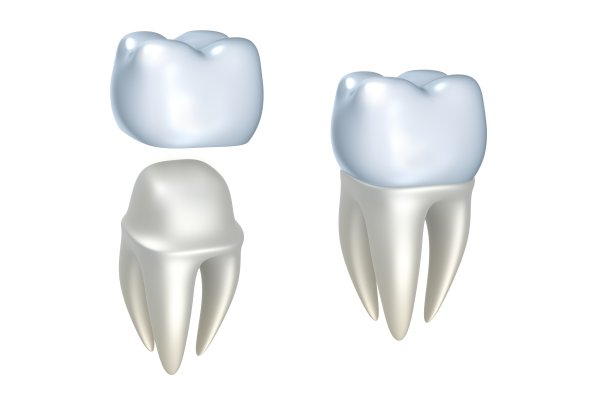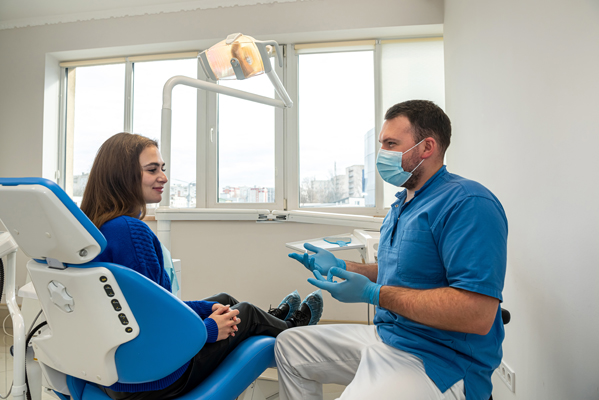Repairing Teeth With Dental Crowns
 At our Delaware dental office, we have a number of ways to help you fix any broken teeth. Among these, the dental crown stands out as one of the most versatile and widely used devices. When you come in with a tooth that is broken, chipped, or cracked, we understand there are two primary areas we need to be concerned about it. The first thing we need to worry about is that when you leave the dental office, you should have a tooth that is completely functional. A tooth's primary responsibility is to start the digestive process by helping you to tear and chew or break down food. Before leaving our office, we need to make sure that the chewing surface is not damaged. The second thing we need to make sure about is that there are no infections and no risk of infections in the cracks of the tooth. If there is such an infection, we want to remove it and quickly seal up the damage so the infection cannot return. In addition to this, we want to make sure that your tooth looks just as healthy as the teeth surrounding it. We want to make sure the tooth does not stand out as once you have received treatment.
At our Delaware dental office, we have a number of ways to help you fix any broken teeth. Among these, the dental crown stands out as one of the most versatile and widely used devices. When you come in with a tooth that is broken, chipped, or cracked, we understand there are two primary areas we need to be concerned about it. The first thing we need to worry about is that when you leave the dental office, you should have a tooth that is completely functional. A tooth's primary responsibility is to start the digestive process by helping you to tear and chew or break down food. Before leaving our office, we need to make sure that the chewing surface is not damaged. The second thing we need to make sure about is that there are no infections and no risk of infections in the cracks of the tooth. If there is such an infection, we want to remove it and quickly seal up the damage so the infection cannot return. In addition to this, we want to make sure that your tooth looks just as healthy as the teeth surrounding it. We want to make sure the tooth does not stand out as once you have received treatment.
Functionality, wellness, and aesthetics are the key three goals of any dental office
We have a variety of ways to accomplish this when you have a damaged tooth. Sometimes, a filling can do the job perfectly, but at other times, we need a more comprehensive solution. One comprehensive solution that we use is a dental crown. Dental crowns are among the most well known and common devices we use. Also known as caps, dental crowns cover the entire tooth so there is no chance of an infection and the tooth will be able to do its job. Here are a few important terms you will hear when you come into the dental office for a dental crown treatment.
The first term we use at our Delaware dental office, and one you will become very familiar with as it refers to dental crowns, is the preparation. In order for us to successfully place a dental crown, it is essential that the preparation is perfect, and this can vary depending on the amount of damage you have on your tooth, the material will be using for your replacement crown, and other historical factors. If you have had a fracture or work done on the tooth previously, it can affect the preparation.
Other terms include margins, which refers to the place where your new crowns touch the gums. It is essential that the margins be smooth, free of any gaps or ledges. This edge of the crown meets the prepared tooth and has no room for error.
Another term that we commonly use is the cusps. These refer to the sharp, chewing error of your teeth. If these are damaged, it is almost guaranteed you will need to get dental crowns to replace them since they are essential to the function of the teeth.
Recent Posts
An implant crown is an important part of dental implants. This is a cap that goes on the end of the implant, acting as the tooth. It is natural-looking in color, shape, and size. If you are missing a tooth, you should not have to live with a gap in your mouth. This treatment can…
A dental crown is an ideal solution for restoring teeth. But there are particular problems that can occur with a crown. If you experience any complications after your crown is placed, you should contact your dentist as soon as you can. Several clues can tell you that your dental crown needs the dentist’s attention. Read…
A dental crown is basically a cap or cover that a dentist puts on the patient’s tooth. Your dentist may recommend that you get a dental crown for one of several reasons. You may need a crown if your tooth is cracked, weakened or severely worn down. In other cases, you can opt to have…
Restoration of a damaged tooth can be achieved through a variety of procedures, but the most common is that of dental crowns. While this procedure has been around for some time, dentistry has continued to evolve. Now, dental crowns are more modern than ever. When considering receiving dental crowns as a way to restore or repair…
Dentist in Delaware
 At our Delaware dental office, we have a number of ways to help you fix any broken teeth. Among these, the dental crown stands out as one of the most versatile and widely used devices. When you come in with a tooth that is broken, chipped, or cracked, we understand there are two primary areas we need to be concerned about it. The first thing we need to worry about is that when you leave the dental office, you should have a tooth that is completely functional. A tooth's primary responsibility is to start the digestive process by helping you to tear and chew or break down food. Before leaving our office, we need to make sure that the chewing surface is not damaged. The second thing we need to make sure about is that there are no infections and no risk of infections in the cracks of the tooth. If there is such an infection, we want to remove it and quickly seal up the damage so the infection cannot return. In addition to this, we want to make sure that your tooth looks just as healthy as the teeth surrounding it. We want to make sure the tooth does not stand out as once you have received treatment.
At our Delaware dental office, we have a number of ways to help you fix any broken teeth. Among these, the dental crown stands out as one of the most versatile and widely used devices. When you come in with a tooth that is broken, chipped, or cracked, we understand there are two primary areas we need to be concerned about it. The first thing we need to worry about is that when you leave the dental office, you should have a tooth that is completely functional. A tooth's primary responsibility is to start the digestive process by helping you to tear and chew or break down food. Before leaving our office, we need to make sure that the chewing surface is not damaged. The second thing we need to make sure about is that there are no infections and no risk of infections in the cracks of the tooth. If there is such an infection, we want to remove it and quickly seal up the damage so the infection cannot return. In addition to this, we want to make sure that your tooth looks just as healthy as the teeth surrounding it. We want to make sure the tooth does not stand out as once you have received treatment.
